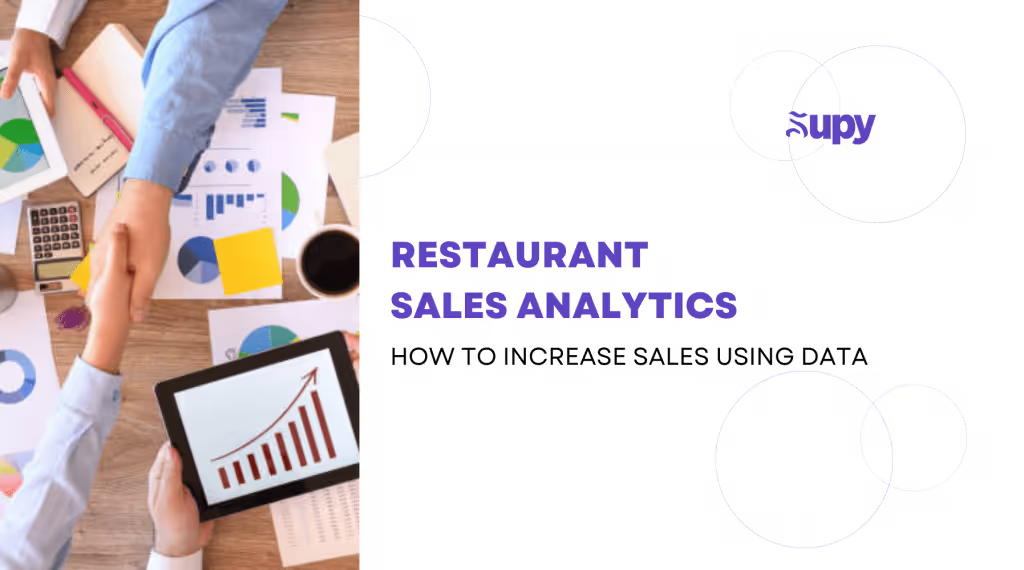Driving Sales Through Effective Online Marketing for Restaurant Chains
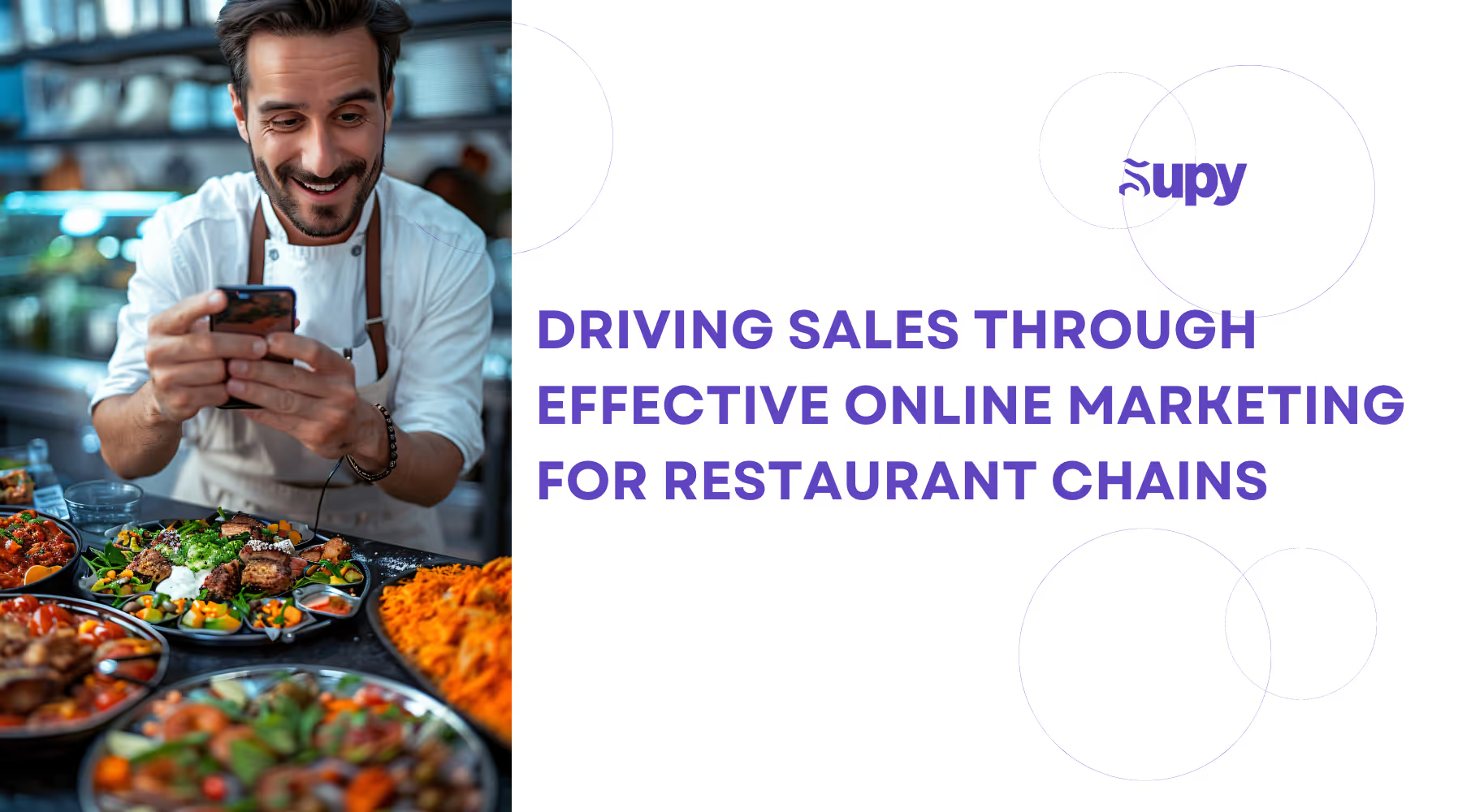
Struggling to fill your tables despite your best efforts? You're not alone. Many restaurant owners face the same challenge, but marketing strategies for restaurants can be your solution. Online marketing can transform your restaurant's fortunes, driving more customers through your doors and boosting your revenue. With the right strategies, your online presence can become a powerful tool for growth and expansion, especially for multi-branch restaurant chains.
- The Importance of Online Marketing for Restaurants
- Top Digital Marketing Strategies for Restaurants
- Online Marketing for Restaurants: Key Factors
- Conclusion
- About Supy
You'll discover how to turn online marketing into a competitive edge for your restaurant chain.
1. The Importance of Online Marketing for Restaurants
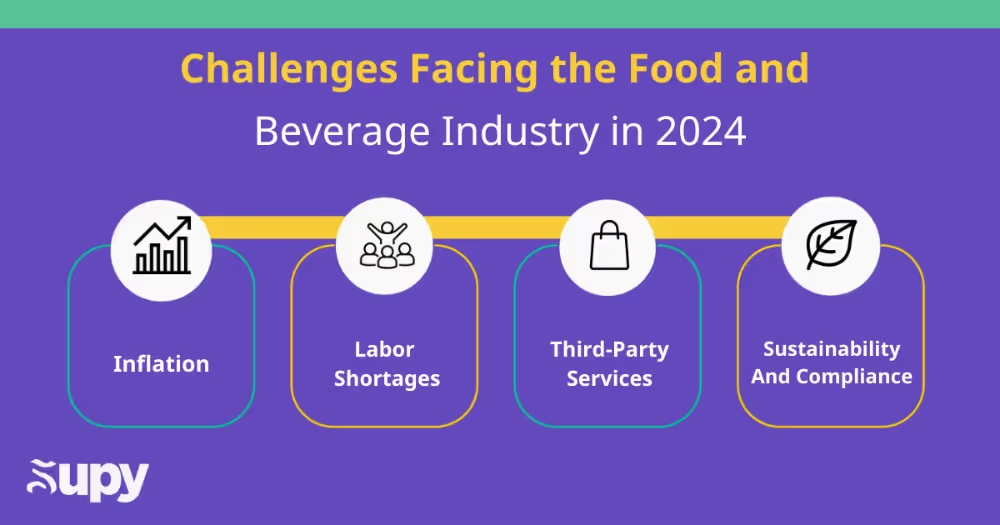
The restaurant industry has seen a significant shift in how businesses reach and engage with their customers. Traditional marketing methods like flyers, radio ads, and word-of-mouth, while still useful, are no longer sufficient. The digital age demands a more dynamic approach, and online marketing has become essential for the restaurant business to thrive.
Traditional offline marketing efforts are often limited by their reach and measurable impact. Digital marketing, on the other hand, allows for precise targeting and real-time analytics, giving restaurant owners invaluable insights into their audience's preferences and behaviors. This shift is driven by changing consumer habits and the increasing importance of an online presence.
Here are some statistics that highlight the necessity of online marketing for restaurants:
- 90% of diners research restaurants online before visiting. A strong online presence is crucial to attract new customers.
- 95% of food and beverage businesses use Facebook. Instagram to promote their offerings. 85% of customers trust online reviews as much as personal recommendations. Hence, managing online reputation is important.
- Digital marketing provides measurable results, offering insights into customer preferences and behaviors. This data-driven approach allows for more targeted and effective marketing efforts, ensuring efficient resource use and a higher return on investment.
- 23% of restaurant business is processed through online orders. Adding online ordering options can lead to a 17% increase in sales. Implementing these technologies expands reach and enhances customer satisfaction, driving both sales and loyalty.
2. Top Digital Marketing Strategies for Restaurants
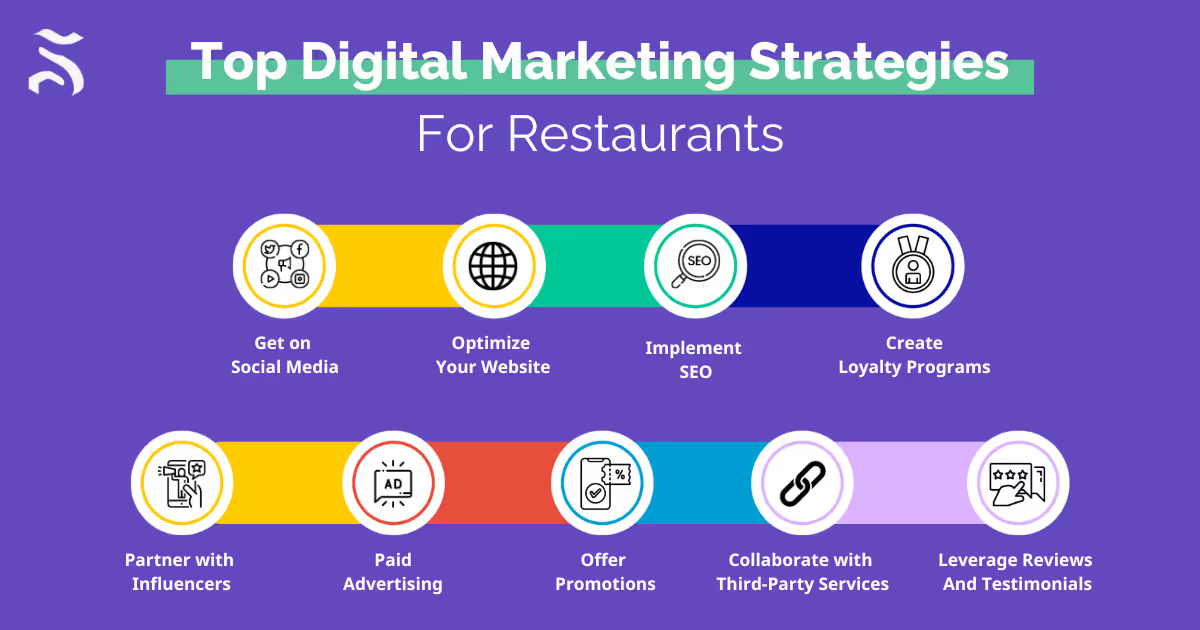
There are several effective ways to enhance your restaurant's online presence and attract more customers. Here are the top strategies you should consider:
1. Get on Social Media
Social media marketing is essential for engaging customers and promoting your restaurant. Here’s how to make the most of it:
- Choose the Right Platforms: Focus on social media platforms like Facebook and Instagram for their visual appeal and large user bases.
For instance, Facebook is ideal for reaching a broad audience due to its wide demographic. Instagram, with its emphasis on visuals, is perfect for showcasing your dishes. TikTok is great for engaging younger audiences with short, creative videos, making it an excellent tool for targeting a younger demographic. - Create Engaging Content: Share high-quality images and videos of your dishes, behind-the-scenes shots, and customer experiences. Highlight seasonal specials, unique events, or a day in the life at your restaurant to keep content fresh and interesting.
For example, Domino's uses Instagram to post mouth-watering images of their pizzas, coupled with interactive stories and IGTV recipes. This type of content is crucial for effective social media management and enhancing restaurant branding. - Interact with Followers: Respond to comments, messages, and mentions promptly.
For example, if a customer tags your restaurant in a positive review, thank them publicly. Address complaints swiftly and professionally to show you value feedback. Engaging with your target audience in this way fosters a loyal community and enhances your restaurant's reputation.
2. Optimize Your Website and GMB Account
A well-optimized restaurant website and Google My Business (GMB) account are crucial for attracting and retaining customers. Here’s how to make sure both are working effectively for your restaurant:
- Ensure Accurate Information: Make sure all information on your restaurant website and business account, including your address, phone number, hours of operation, and website link, is accurate and up-to-date.
This prevents potential customers from getting frustrated by outdated or incorrect details, ensuring they can easily find and contact your restaurant. - Optimize for Mobile Responsiveness: Ensure your website is mobile-friendly, as over 60% of searches are conducted on mobile devices.
A user-friendly website with responsive design ensures that your site looks great on all screen sizes and provides a seamless user experience, which can significantly impact your search rankings and customer satisfaction. - Include Clear Calls to Action (CTAs): Whether on your website or GMB profile, make sure to include clear and compelling CTAs. Encourage visitors to make reservations, order online, sign up for newsletters, or follow your social media accounts.
3. Implement SEO Best Practices
Search Engine Optimization (SEO) is crucial for making your restaurant visible to potential customers online. By implementing SEO best practices, you can improve your search engine rankings and attract more local traffic. Here’s how to do it effectively:
- Use Local Keywords: For multi-branch restaurants, optimize your website and content for local searches. Include local keywords that specify your restaurant’s locations. For example, instead of just using “best pizza,” use “best pizza in [city name].”
- Build Local Backlinks: Acquire backlinks from reputable local websites to enhance your site's authority and improve local search rankings. This could include local news websites, blogs, or business directories. Participating in local food festivals or charity events can be a great way to get featured on local news sites, which boosts your SEO.
- Create Local Content: Develop content that resonates with your local audience. This could be blog posts about local events, partnerships with local businesses, or stories about your restaurant’s involvement in the community.
Regularly updating your blog with relevant local content keeps your website fresh and engaging, further improving your local SEO and strengthening your restaurant marketing strategy.
4. Create Loyalty Programs
Loyalty programs are a powerful tool for retaining customers and encouraging repeat business. By offering rewards and incentives, you can build a loyal customer base and increase sales. Here’s how to create effective loyalty programs for your restaurant:
- Offer Exclusive Discounts and Rewards: Create a tiered loyalty program where customers earn points for every purchase. These points can be redeemed for discounts, free items, or special perks. This not only incentivizes repeat visits but also makes loyal customers feel valued.
- Implement a Digital Loyalty Program: Use digital platforms to manage your loyalty program. Apps like Belly and FiveStars allow customers to track their points and rewards easily. Digital programs are convenient for customers and provide valuable data on customer preferences and spending habits, helping you tailor your marketing efforts.
- Promote Your Loyalty Program: Make sure your existing and potential customers know about your loyalty program. Promote it on your website, social media, and in-store. Train your staff to inform customers about the program and encourage them to sign up.
5. Partner with Influencers and Food Bloggers
Partnering with influencers and food bloggers can significantly boost your restaurant’s visibility and credibility. By leveraging their large followings and trusted voices, you can reach new audiences and enhance your brand’s reputation. Here’s how to effectively partner with influencers and food bloggers:
- Identify the Right Influencers: Look for social media influencers and food bloggers whose audience aligns with your target demographic. For instance, if you run a vegan restaurant, partner with influencers who focus on vegan and plant-based content. This targeted approach ensures that your influencer marketing efforts are more effective and reach the right audience.
- Create Authentic Collaborations: Work with influencers to create authentic and engaging content. This could include reviews, sponsored posts, or social media takeovers. Ensure the content feels genuine and reflects your brand’s values. Authentic collaborations are key to successful restaurant digital marketing as they build trust with the audience.
- Offer Exclusive Experiences: Provide influencers with unique and exclusive experiences that they can share with their audience. This could be a behind-the-scenes look at your kitchen, a cooking class with your chef, or an invitation to a special event. Exclusive experiences create buzz and provide valuable content for the influencer.
6. Invest in Paid Advertising
Investing in paid advertising is a powerful way to boost your restaurant’s visibility and attract more customers. By strategically using online ads, you can reach a broader audience and drive more traffic to your website and physical location. Here’s how to effectively invest in paid advertising:
- Utilize Social Media Ads: Platforms like Facebook, Instagram, and Twitter offer robust advertising tools that allow you to target specific demographics based on age, location, interests, and behaviors. For instance, you can run ads promoting a new menu item to users in your local area.
- Leverage Geotargeted Ads: Use geotargeted ads to reach potential customers in your specific area. This involves setting your ads to appear only to users within a certain radius of your restaurant. Geotargeted ads are effective for promoting local specials, events, and new menu items.
- Use Retargeting Ads: Retargeting ads are a way to reach users who have previously visited your website but didn’t convert. By displaying ads to these users as they browse other websites, you can remind them of your restaurant and encourage them to return. This strategy is essential for reinforcing your restaurant digital marketing strategy and maximizing return on investment.
7. Offer Promotions and Discounts via Mobile Apps
Using mobile apps to offer promotions and discounts is an effective way to engage customers and boost sales. Mobile apps provide a direct and convenient channel for communicating special offers and incentives to your customers. Here’s how to do it effectively:
- Develop a User-Friendly App: Create a mobile app that is easy to navigate and visually appealing. Ensure it offers a seamless user experience with features like mobile ordering, reservation booking, and a loyalty program.
- Push Notifications for Instant Engagement: Use push notifications to instantly alert customers about new promotions, discounts, and special events. For example, send a notification about a limited-time discount on your popular dishes during off-peak hours to drive traffic.
- Exclusive In-App Offers: Offer promotions and discounts exclusively through your mobile app to encourage downloads and usage. Exclusive in-app promotions can also lead to free purchases for loyal customers, enhancing customer satisfaction and loyalty.
8. Collaborate with Third-Party Services
Collaborating with third-party services can expand your restaurant's reach and streamline operations. By partnering with established platforms, you can attract more customers, improve efficiency, and enhance your overall service. Here’s how to do it effectively:
- Partner with Food Delivery Apps: Collaborate with popular food delivery services like Uber Eats, DoorDash, and Grubhub. These platforms have vast user bases and can significantly increase your restaurant’s exposure and sales. These partnerships can be a key component of your restaurant marketing strategies.
- Utilize Reservation Platforms: Use reservation management services like OpenTable or Resy to streamline your booking process. These platforms make it easy for customers to find and reserve a table at your restaurant, reducing no-shows and optimizing table turnover.
- Integrate with POS Systems: Implement a robust Point of Sale (POS) system that integrates with other third-party services. These integrations can enhance efficiency and provide valuable insights into your operations, allowing you to focus more on customer service and less on administrative tasks.
9. Leverage Reviews and Testimonials
Customer reviews and testimonials are powerful tools that can significantly impact your restaurant’s reputation and attract new patrons. Positive feedback serves as social proof, helping to build trust and credibility with potential customers. Here’s how to effectively leverage reviews and testimonials:
- Encourage Satisfied Customers to Leave Reviews: Actively ask happy customers to leave positive reviews on review sites like Google, Yelp, TripAdvisor, and your social media pages. You can do this by including a request on receipts, sending follow-up emails, or directly asking during their visit.
- Respond to Reviews Promptly: Engage with all reviews, both positive and negative. Thank customers for their positive feedback and address any concerns raised in negative reviews professionally and promptly. This shows that you value customer feedback and are committed to providing excellent service.
- Showcase Testimonials on Your Website: Highlight positive testimonials on your website and social media channels. Create a dedicated testimonials page or feature quotes on your homepage. Ensure that the testimonials are genuine and reflect the strengths of your restaurant.
3. Online Marketing for Restaurants: Key Factors

Successfully marketing your restaurant online involves considering several essential factors to ensure you reach and engage your audience effectively. Here’s what you need to focus on:
- Cost Considerations: Establish a clear budget for your online marketing efforts. Decide how much you can allocate to social media ads, Google Ads, and influencer partnerships. Keep track of your spending and adjust based on what’s working. Remember, even a small budget can go a long way with the right marketing plan.
- Data Analytics: Use data analytics and social media insights to track how well your campaigns are performing. Look at metrics such as traffic sources, site visits, and engagement levels with your content. This data is invaluable for tweaking your strategies and making data-driven decisions that can improve your restaurant promotions and attract customers more effectively.
- Targeted Advertising: Focus your marketing efforts on the people who are most likely to visit your restaurant. Use geotargeted ads to reach local customers and tailor your content to their tastes and preferences. This way, you’re not just casting a wide net, but actually reeling in the right customers, making your marketing plan more efficient and effective.
- Engagement Strategies: Build a strong online presence by actively engaging with your customers. Respond to their comments on social media, thank them for their reviews, and keep your content fresh and interesting. Creating a community around your brand makes customers feel valued and encourages loyalty. Restaurant marketers should focus on fostering a sense of community and interaction to build long-term customer relationships.
- Consistency and Adaptability: Keep your online presence consistent by regularly updating your website, social media, and Google My Business profile. Stay flexible and ready to adapt to new trends and customer feedback. This ensures your marketing efforts are always on point and relevant, helping you to continuously attract customers and keep them engaged with your restaurant.
4. Conclusion

Successfully marketing your restaurant online can seem daunting, but with the right strategies, it can be incredibly rewarding. By leveraging social media, optimizing your website, and implementing SEO best practices, you can create a vibrant online presence that draws in customers.
Don’t forget the power of engaging with your audience and using data to guide your efforts. With a thoughtful and consistent approach, you can build a loyal customer base and ensure your restaurant thrives in the digital landscape.

5. About Supy
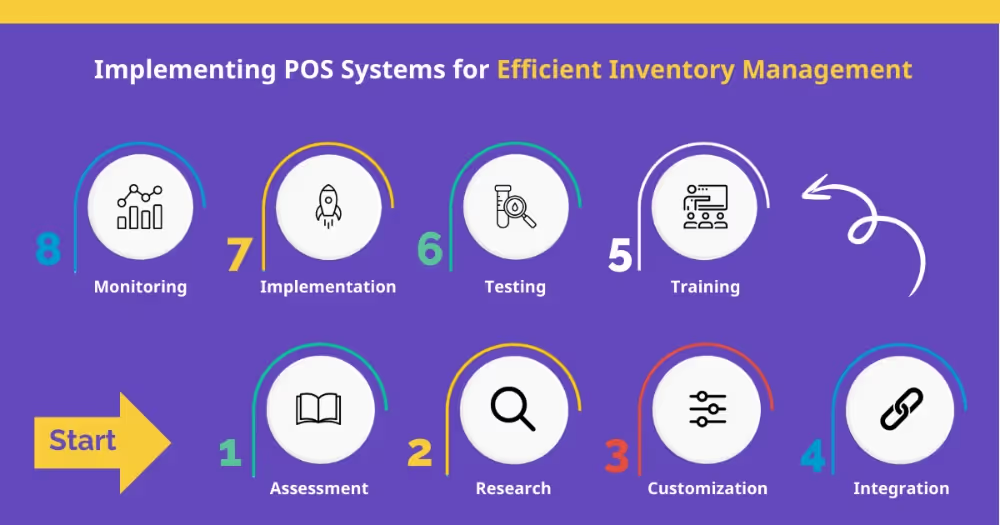
At Supy, we understand the challenges of running a successful restaurant. Our data-driven inventory management software helps you cut costs, reduce waste, and maximize profits by providing real-time insights and automating processes like ordering ingredients. Pair these strategies with the online marketing tips from this blog to enhance your restaurant's efficiency and customer reach.
Ready to optimize your operations? Book a demo today and see how Supy can transform your business.




